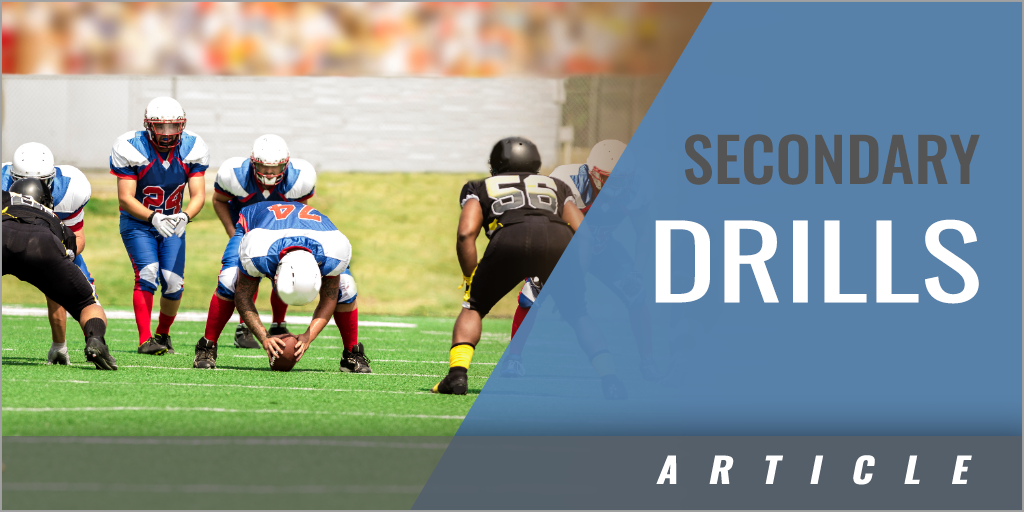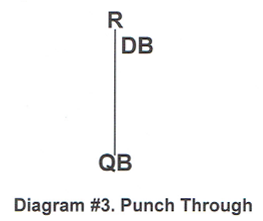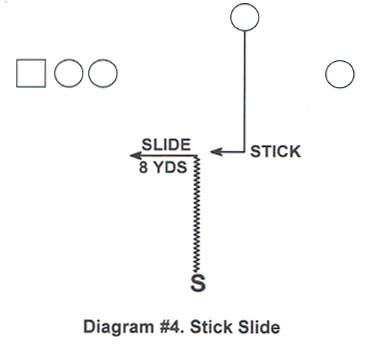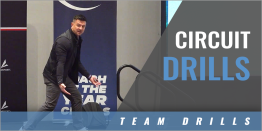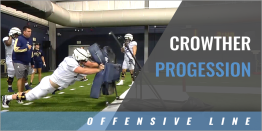|
By: Mike Treier Originally Published in: 2019 Nike Coach of the Year Clinic Manual - by Earl Browning Provided by: Nike Coach of the Year Thank you, I appreciate all of you coaches staying around to listen to me. I will start with an overview of how things are going to go. I am going to start with some man coverage techniques. I will get into some secondary base techniques and some tackling techniques. Just real quickly I want to talk about Marshall University. Marshall has had a lot of success recruiting in Kentucky, going back to Chad Pennington back in the day. We signed two players out of Kentucky last year. We signed Arak McDuffie out of Trinity High School right here in Louisville and Dalton Tucker from Paris, Kentucky. They played a lot of football for us this year. We have recruited Kentucky and Tennessee hard the last two years. Doc Holiday has been at Marshall starting his tenth year. He is the only coach in college football that lives in the same house he grew up in. He is Marshall's head coach and is not going anywhere. Marshall is the only school in the country that has won seven consecutive bowl games. Doc Holiday was the head coach for six of those games. He is 6-0 in those games. We have had a lot of success in bowl games and we hope it will continue. We have a new defensive coordinator, Brad Lambert. He was the head football coach at Charlotte last year. I want to start with our man coverage. We are a press team into the boundary. We are a wide press team to protect against the RPO schemes that people are running today. You have to take away that space right now with all the slants and bubble screens teams are running. We talk a lot about separation of leverage. We moved our corners last year to safeties. We are trying to disrupt the timing of the routes the receivers are running. We told our players that the quarterbacks and receivers have been working all summer throwing routes on air. Their patterns and RPO's depend on timing. If you do not disrupt the timing of the throws, you do not have a chance. It is a complicated issue by the way referees call pass interference and hand fighting. We are a big split rule team. I will go over the stance in a minute. Our stance is a little different than high school teams might think. Our normal split into the boundary is on the numbers. (Diagram #1) We used to play outside leverage as a rule for a split into the boundary. However, the game has changed, especially in man-free coverage.
The quarterbacks have become so mobile the role-players in the middle are neutralized. The quarterbacks scramble so much the coverage is not reliable. Now, on a normal split into the boundary, we play in a heads-up leverage position. That allows the release of the receiver to help identify the route he is running. With an outside release, the receiver is going to run an out, come back, or fade route. The inside release leads to curls, digs, and slants. With the head up position, the release of the wide receiver helps our corners identify the route. If the receiver aligns at the bottom of the numbers, we treat that as an over-split alignment. To that alignment. we align on the inside shoulder. That puts the outside shoulder of the defensive back on the inside shoulder of the receiver. An under split is by definition the top of the numbers. On that alignment by the receiver. the defensive back takes an outside leverage position. We feel the receiver tightens up his split to give him more room into the boundary to run the pattern A minus split is three yards off the top of the numbers. We operate with a 90-percent rule. If the receiver has a minus split, there is a 90-percent chance he is going to do one of three things. He is going to crack block. run an under route, or over the route. The defensive back gets off those splits so he can see what is happening. In our stance. we want the feet shoulders width apart with the knees bent. I do not get caught up with the position of the hands. Most people teach the stance with the hands up. Some players get more comfortable with their hands dangling in a natural position. I do not get too caught up on that as long as they can get the jams. We teach an alignment one yard off the receiver. If he is on the line of scrimmage we are one yard off him. If he is off the line of scrimmage. we want to get as close to the line of scrimmage without being offsides. We are like a wide receiver in this case. We ask the official about our alignment. We want all the line we can get. We teach the inch back technique" and delay the confrontation with the receiver immediately. The reason is the receivers today are bigger and taller than in the past. If we press the contact with the receiver. the receiver grabs the defensive back's hands and uses them as leverage. We are staying square on the receiver as long as the receivers stay square. If the receiver is trying to drive step or hotfoot the defensive back, he is wasting time. That gives the pass rusher more time to get to the quarterback. Once the receiver declares a side on the defensive back, the back takes a 45-degree angle step to get into position. He wants to jam with the offhand. The reason he does not jam with the release side hand is the receiver will grab the elbow and lock it to his side. Once we get the 45-degree step in the ground, the defensive back is playing the deep ball. If it is an inside release, he is playing the post-throw. If it is an outside release he is playing the fade. We react back to all the short patterns. There are three levels of routes. The first level is the quick throws. That amounts to slants. bubbles, and hots. The immediate routes are digs. curls. and out routes. These routes brake at a depth of 10 to 14 yards. The third level is the vertical routes. In the stance. we want the weight on the balls of the feet. The eyes are on the belt buckle of the receiver. The corner does not want to force contact with the receiver. Our defender plays with a one-yard space between them. He stays square as long as the receiver stays square. The back lets the receiver dictate the routes he is going to run. If the receiver takes an inside release, the corner has to turn and get his inside foot in the ground at a 45-degree angle and his outside hand on the receiver. He has to keep his inside hand away from the receiver. The keys to this technique are to make the receiver run the hump instead of coming straight out. (Diagram #2) I do not care how fast the corner is. if he starts backward and the receiver is running forward, he is going to beat the corner in a race.
You cannot allow him to run straight down the field. The corner has to make the receiver run around the corner. The offhand does not have to be a hard jam. You do not have to be very physical with the jam. We have a technique which allows the corner to jump the receiver, but as a rule, we want to contact with the offhand as the hips open at a 45-degree angle to run with the receiver. We are trying to feel the route the receiver is running. When the receiver takes an over-split to the bottom of the numbers, the corner aligns on the inside shoulder of the receiver. The reason the receiver is taking an over-split is to open the space to the inside. If the receiver steps outside that is a fake, and he is not going to over-split and run outside. The corner cannot overreact to the foot movement. The technique does not change. The only different thing is the first step. We still have to make the receiver run the hump and not give him a straight line run up the field. Once the foot gets into the ground it becomes a race between the receiver and the corner. The bottom of the cleats should not have much space between the shoe and the grass. When you play defensive back or any position, you must have the ability to keep the feet on the ground. The inside foot has to be on the ground before the corner makes contact with the receiver. If he makes contact before he gets the foot down, the receiver will push him off balance and back, which gives him a straight line off the ball. We do not want that to happen. We must make the receiver run the hump around the corner to disrupt the timing of the route. With a normal split, the corner is in a heads up alignment one-yard off the receiver. He is one-yard off the receiver, eyeing the belt buckle. If the receiver uses an inside release, the corner has to think deep post as his first thought. If the receiver breaks the pattern into a slant pattern, the corner reacts and plays through the receiver's hands. In an over-split alignment by the receiver, the corner takes an inside leverage position on the receiver. We want to deny the early confrontation, The receiver wants to keep the one-yard cushion to take the hands away from the wide receiver. If the receiver runs an outside release, our first thoughts are a deep ball. We want to delay the confrontation to give our pass rusher more time to get to the quarterback. The corner has to make the receiver run the hump and not give him a straight line release. That is what the quarterbacks and receivers have worked all summer on while they build the timing for the route. A coaching point for the inside alignment is to make sure the corner releases straight back in his drop. They tend to pinch inside, which gives the receiver a straight line release. The corner has to retreat straight back and his alignment will cause the receiver to run the hump. The next thing we cover is the immediate routes in the 10-14 yard range. These are the digs, curls, and out routes. For the corner, this coverage is all about leverage and separation. The receiver has to get leverage and separation from the defensive back. It is the corner's job to take that away from the receiver. With press-man coverage, we have automatically taken away the separation factor. The corners will be on the receiver's hips in the break off the line of scrimmage. The route now becomes all about leverage. If the receiver uses an outside release and wants to run a dig pattern, the receiver does not have the correct leverage. The receiver has to create the leverage to run the pattern. If the receiver inside releases on the dig pattern, he has the leverage he needs to run the pattern but he does not have the separation. If he has the leverage but not the separation, the receiver has to use a "push-off' to gain separation. We expect them to do it. I tell our guys if the offense is going to cheat, we are too. We are going to assume they are going to use their hands to create the separation they need. If they are going to use their hands on us, we are going to use our hands on them. I am not coaching the corners to hold or grab them. I have gotten smart in the way I coach the cheating. In practice, we work the push-off drill. When the receiver puts his hand on the corner, the corner puts his hand on the receiver. He is grabbing the hip of the receiver. Referees look for a jersey pull or the hand high on the back of the receiver. That is an automatic interference call. We are coaching to be low on the hip as our focal point. The corner defender gets on and off with his hands so the receiver cannot create separation. The corner cannot react until the receiver puts his hands on the corner. The corner has to keep his hands low. If he gets them too high, he ends up on the back and the official can see that. The last scenario is where the receiver does not have leverage or separation. However, the receiver must create leverage and separation. In that case, the receiver has to throw the defender by the breakpoint so he can get inside. When the receiver puts his hand on the back of the corner to push him by the breakpoint, the corner puts his hand on the back of the receiver. The corner allows the receiver to throw his hips open for him. As the receiver pushes on the back of the corner, the corner naturally lets his hips open to the inside. The important thing is to let the receiver put his hands on the corner first. If it occurs the other way with the corner hands first, it is interference. This technique is huge on a third-down play. Teams will run a chain route to get the first down. They run their patterns the depth of the chains. They use the throw by technique to get the corner off him. They run to the chains and push off to get separation. When they put their hands on us. we get our hands on them. The next phase is the deep ball. We talk about three different positions on the deep ball. When I came to Marshall in 2013. we taught the corner to go cut off the receiver and become the receiver. That technique changed with the back shoulder throw. We had to come up with a technique that fits that pattern. The ideal position is hip to hip. We call that in the phase position. From this position, we are expecting two throws. We expect the over the top throw or the back shoulder throw. On the over the top throw, we use the look-technique. On the back shoulder throw, we use a chest-to¬chest technique. If the corner is hip-to-hip with the receiver, the receiver does not know which throw is coming. The quarterback is reading the defensive back and makes the over the top or back shoulder throw. The corner has to read the receiver's eyes. If the ball is over the top, the corner reads the receiver's eyes and reacts to the throw. If it is the back shoulder throw, he has to get his foot in the ground and play that throw. If the corner uses a look technique, he is going to look back for the ball. To locate the ball he has to look up and then back. If he only looks back, he will never see the ball come down. The corner's eyes go up and take the same path as the ball. As the eyes go up, the body leans on the receiver. That keeps the receiver from getting separation. If the corner gets into an out of phase position, the only play he has is to plays the receiver's hands and eyes. The corner is running to try to get back into phase. He cannot see the ball and does not look for it. He has to play the reaction of the receiver. Even in phase. the corner has to run pumping both arms. If he stops using both arms to run, the receiver will outrun him. If the receiver is pumping both arms and the corner is pumping only one arm. the receiver will win the race. When we are running in phase, we are not trying to look back at the quarterback. We look at the eyes of the receiver. He will tell you when to look. When his eyes start to get big, we look up and back for the ball. When you drill this. it is simply a one-on-one drill. In the deep ball drills, I try to save the players legs by running abbreviated patterns. However, you cannot tell the receiver to run a back shoulder pattern at five yards. If you do that the defensive backs will play the pattern at five yards. This play is all about reaction. I tell the receivers to run the back shoulder between five and ten yards. Anywhere within that yardage, they stick their foot in the ground and get ready for the back shoulder. When I do this drill, I like to start without a ball. I have then progressed to the receiver with the ball, and finally do the complete throw. It is a reaction drill. The corner does not have time to look back for the ball. As soon as he sees the receiver stick his foot in the ground to stop. he has to stick the upfield foot in the ground and get chest to chest with the receiver. You are not going to pick off the back shoulder throw unless it is a bad throw. It happens too fast. The defensive back has to plant his upfield foot, get chest to chest, and match the hands of the receiver. On the over top throw, we always play with the near arm to the ball. We want to match the receiver's hands and try to play down through the ball. The problem with playing up through the ball is the chance that the ball will deflect up into the air and give the receiver a second chance to catch the ball. It happens all the time. On the back shoulder throw. there will be more playing up through the ball than down through it. When the corner jams his foot in the ground. I want the upfield foot jammed. There is more power when the corner comes back for the ball. If the corner gets beat at the line of scrimmage or with a double move. his job is to get in phase. It does not matter if he is two yards or five yards out of phase. His number one job is to run as fast as he can to get to the receiver. He is not looking back for the throw. He has to get to the receiver. When the corner plays the ball, he does not want to wind up with his arm and try to tomahawk the ball. That takes too much time. We want to go through the hands and knock the ball down. We want to match the hands of the receiver as quickly as we can. The mistake that some corners make is trying to guess when the ball is coming. Instead of playing through the hands, they try to guess when the quarterback releases the ball. I run a drill to help teach going through the hands. (Diagram #3) I have a quarterback. a corner, and a receiver. In the drill the receiver offsets from our corner. The corner has his back turned to the quarterback. He is reading the receivers eyes and playing the throw.
When the receiver reacts to the throw. the defensive back fires through the hands of the receiver. The defensive back wants to take the hands away from the receiver. The receiver cannot catch the ball without his hands. The drill is an immediate pass depth with the defender one yard off the receiver. The defender punches through the palms of the receiver. In our man-free coverage, we teach the safeties a catch technique. The catch technique happens at eight yards. The base way we teach it is to drop down with outside leverage on the receiver. We have split rules for the slot receiver just like we did with the boundary corner. The normal alignment is the hash mark. If the receiver aligns on the hash, the safety drops down with outside leverage on the receiver. If the receiver gets two yards outside the hash mark, the safety drops down with inside leverage. The technique in the catch will not change but his leverage changes. On the snap or the ball. the safety is coming down to eight yards with outside leverage and buzzing his feet. He is not chopping his feet. He is moving but keeping them close to the grass. He does not want to have his feet off the ground when the receiver runs a pattern. The safety knows his leverage and he knows what the stick pattern means. (Diagram #4) No wideout is going to run a dig pattern and round it off. He is going to stick the pattern and come inside. We are going to teach the safety to slide the stick. If the receiver runs vertical and sticks his foot at 14 yards, the safety wants to slide opposite the stick of the receiver.
In our 2-man technique. we teach two different techniques. If we are going to play a bailout that week, we bail to five yards and slide to the inside shoulder. If we are playing a lot of press that week, we jump to the inside leverage position. In 2-man there is no help in the middle of the field. We have to force an outside release by the receiver. The corner wants to work from an inside hip position. We can let a receiver run by us and get into a trail position. The work starts at the top of the route. We must get on the receiver's inside hip and mirror his route. The problem is a defender that gets in phase and gets blown by where he has no help. The place he has help is over the top. We want the ball thrown to the outside and over the top. When we do drill work on 2-man coverage, the drill starts from the top of the routes. When we teach the bail technique, the corner does not square-up until the center snaps the ball to the quarterback. We want to sell the cover-3 look. If the corner bails and gets five yards before the ball comes back to the quarterback, the corner does not square himself up. If the corner bails and the receiver takes an inside release, the corner has to go hard inside and beat the receiver to the spot. He cannot let him get down the middle because there is no help to the inside. You must know where your help is coming from on the play. The sideline is help and the half field safety is help. I want to get into tackling quickly. Ninety-percent of our tackles come in three different scenarios. We teach an angle tackle, which is inside/out, and you have leverage. It could be a leverage player or a sideline. but you have a leverage point. In that type of tackle, we teach the defenders to stay high on the tackle. The next tackle we teach is an angle tackle without a leverage point. The ball carrier can run away from the tackler. In that situation, we teach a double leg takedown. That method of tackling has appraised in the last few years. We teach facemask on the hip. With all the debate about the head and tackling, we are trying to find a middle ground. We are not putting the head across or behind. We are attacking the hip with the facemask. With the facemask on the hip, when the runner falls the head will be behind the runner. We teach this method all across the defense. We want the eyes on the hip. When we have the runner pinned to the sideline we stay high and run him out of bounds. When we tackle a wide receiver. the tackling has to be more concentrated. Receivers have more speed and skills to elude tackles. We do not want to go low on a wide receiver. We want to close the space with this type of tackle. We want to close as quickly as possible. When we tackle in practice we do not take the players to the ground. In drills, some people allow the tackler to run by the ball carrier and tag him. We go further than that. We make the tackler come with two hands and the palms up. He has to tag him below the waist. If we do it that way, we have put the defender in position to make the tackle. In conjunction with our tackling. we use the one-man sled. It promotes a more physical tackle and works on driving the legs through the tackle. It gives us the feeling of running through the tackle without tackling humans. We use the tackling donut in some of our drills. We roll the donut out and the tackler fires through the dummy and elevates it over his head as he runs through the tackle. I am going to stop right here and see if there are any questions you would like to ask. I guess we are good. Thank you and I appreciate you being here. Go Herd! |
